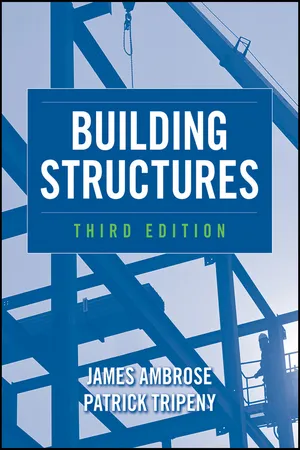Technology & Engineering
Types of Beam
Beams in engineering can be categorized into different types based on their structural behavior and shape. Common types include simply supported beams, cantilever beams, fixed beams, and continuous beams. Each type has specific applications and is designed to withstand different types of loads and forces, making them essential components in various structures and construction projects.
Written by Perlego with AI-assistance
Related key terms
3 Key excerpts on "Types of Beam"
- eBook - ePub
- James Ambrose, Patrick Tripeny(Authors)
- 2011(Publication Date)
- Wiley(Publisher)
Chapter 3 Structural Elements This chapter treats the considerations for investigation of the behavior of various basic structural elements. These are the building blocks from which structural systems are developed. 3.1 BeamsThe generic name for a structural member (element) that is used for spanning, sustains lateral (perpendicular) loading, and develops internal resisting force actions of bending and shear is a beam. Depending on its particular task in a structural system, a beam may be further described as a joist , rafter, purlin , girder , header , or lintel ; however, for its fundamental behavior, it is classified as a beam.Types of BeamsThe most frequently used beam is the simple beam . As shown in Figure 3.1 a , this consists of a single-span beam with supports at each end, offering only vertical force resistance. Because the supports do not offer restraint to the rotation of the beam ends, the beam takes the simple curved form of deformation as shown in the figure.Figure 3.1 Types of Beams.Supports that do not restrain rotation are called free , pinned , or simple supports. Thus the beam in Figure 3.1 a is actually a simply supported beam, although it is more commonly called a simple beam.A cantilever beam consists of a single-span beam with only one end support, as shown in Figure 3.1 b . For stability of the beam, this support must be a rotation-resisting support, called a fixed support or a moment-resisting support .Cantilevers exist less often as shown in Figure 9.2 b than as extensions of beam ends over their supports, as shown at the right end of the beam in Figure 3.1 c . The beam with an extended end is called an overhanging beam .While the simple beam and single cantilever have deformed shapes with simple single curvature, the overhanging beam has multiple, or double, curvature (S shaped when the beam has a single extended end). This form of curvature is also found in beams that are continuous through more than one span, as shown in Figure 3.1 d - eBook - ePub
- William Bolton(Author)
- 2012(Publication Date)
- Routledge(Publisher)
2 Beams and columns2.1 IntroductionAs discussed in chapter 1 in relation to possible forms of loading structures, one basic form involves bending. Thus, for the simple beam bridge in Figure 2.1(a) the load arising from a car crossing it will tend to bend the beam.Figure 2.1 Examples of structures where (a) bending (b) compressive loading occursAs also discussed in chapter 1 , another form of loading involves the loading in compression. Such members might be concrete or brick columns supporting the floors or roof of a building (Figure 2.2(b) ), the applied loads of the floors or roof above applying compressive loads.This chapter is a discussion of loading due to bending, the various forms it can take, and the stresses that can arise from such bending and also the loading of columns.2.2 BeamsA beam can be defined as a structural member, generally horizontal, to which loads are applied and which cause it to bend. As a result of loads causing one surface of a beam to become longer and the opposite surface shorter, when beams bend they become curved.2.2.1 Types of BeamsThe following are some examples of Types of Beams:1 Cantilever (Figure 2.2(a) ) This is a beam which is rigidly fixed at just one end, the other end being free.2 Simply supported beam (Figure 2.2(b) ) This is a beam which is supported at its ends on rollers or smooth surfaces or one of these combined with a pin at the other end.3 Simply supported beam with overhanging ends (Figure 12.2(c) ) This is a simple supported beam with the supports set in some distance from the ends.4 Built-in beam (Figure 2.2(d) ) This is a beam which is built-in at both ends and so both ends are rigidly fixed.Figure 2.2 Examples of beamsWhere an end is rigidly fixed there is a reaction force and a resisting moment. At a supported end or point there are reactions but no resisting moments. At a free end there are no reactions and no resisting moments. Thus, with a cantilever (Figure 2.3 - eBook - ePub
- Mark Lawson, Peter Trebilcock(Authors)
- 2004(Publication Date)
- Taylor & Francis(Publisher)
Chapter 4 Types of Beams, columns and trusses
The main types of structural members that may be encountered in general building construction are described in the following sections. These members are usually concealed or are generally not of architectural significance, but an understanding of the range of structural options is important.4.1 Beams
Beams are designed to resist bending moments and shear forces. The shapes of hot-rolled Universal Beams (UBs) listed in Table 1.1(a) are designed to achieve optimum bending properties for the use of steel. The proportions of well-designed beams fall within relatively narrow limits, depending on the form of loading. As a rule of thumb, sections with a span:depth ratio of 15 to 18 may be used in the scheme design of uniformly loaded steel beams, i.e. for a span of 10 m, the steel beam will be approximately 600 mm deep.Steel beams can also be designed to act compositely10 with a concrete floor slab by use of welded shear-connectors, a technique that has achieved great success in North America and in the UK. Its advantages have been realised in so-called ‘fast-track’ construction by using steel decking as a working platform, as permanent formwork, and as a composite slab acting with the in-situ concrete (see Section 4.1.4 on composite beams).4.1.1 Floor grillages
The layout of floor beams in buildings depends largely on the spacing of the columns. Often columns can be spaced closer together along the edges of the building, in order to support the façade elements. The primary beams span between the columns, and support secondary beams which then support the floor slab. In most buildings with regular bays, the primary beams support more load than the secondary beams, and are therefore heavier and generally deeper. However, in buildings with unequal bays (e.g. 6 m × 7.5 m), it is possible to design the primary beams to span the shorter distance between columns, so that primary and secondary beams can be designed to be of similar depth.
Index pages curate the most relevant extracts from our library of academic textbooks. They’ve been created using an in-house natural language model (NLM), each adding context and meaning to key research topics.


